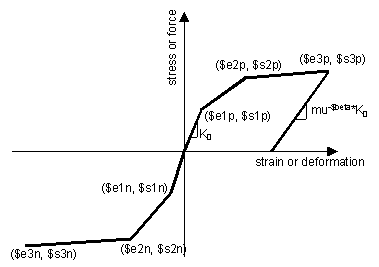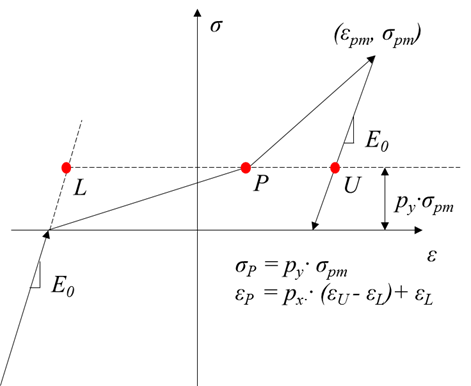Hysteretic Material
From OpenSeesWiki
Jump to navigationJump to search
This command is used to construct a uniaxial bilinear hysteretic material object with pinching of force and deformation, damage due to ductility and energy, and degraded unloading stiffness based on ductility.
| uniaxialMaterial Hysteretic $matTag $s1p $e1p $s2p $e2p <$s3p $e3p> $s1n $e1n $s2n $e2n <$s3n $e3n> $pinchX $pinchY $damage1 $damage2 <$beta> |
| $matTag | integer tag identifying material |
| $s1p $e1p | stress and strain (or force & deformation) at first point of the envelope in the positive direction |
| $s2p $e2p | stress and strain (or force & deformation) at second point of the envelope in the positive direction |
| $s3p $e3p | stress and strain (or force & deformation) at third point of the envelope in the positive direction (optional) |
| $s1n $e1n | stress and strain (or force & deformation) at first point of the envelope in the negative direction |
| $s2n $e2n | stress and strain (or force & deformation) at second point of the envelope in the negative direction |
| $s3n $e3n | stress and strain (or force & deformation) at third point of the envelope in the negative direction (optional) |
| $pinchx | pinching factor for strain (or deformation) during reloading |
| $pinchy | pinching factor for stress (or force) during reloading |
| $damage1 | damage due to ductility: D1(mu-1) |
| $damage2 | damage due to energy: D2(Eii/Eult) |
| $beta | power used to determine the degraded unloading stiffness based on ductility, mu-beta (optional, default=0.0) |
NOTE:
- In cases $s3p > $s2p and abs($s3n) > abs($s2n), the envelope of the hysteretic material after $e3p or $e3n follows the slope defined by 2nd and 3rd point of the envelope.
- In cases $s3p <= $s2p and abs($s3n) <= abs($s2n) the envelope of the hysteretic material after $e3p or $e3n is a flat line with a constant stress (or force) equal to $s3p or $s3n.
Examples:
Effects of Hysteretic-Material Parameters [1]
Code Developed by: Michael Scott (Oregon State University) & Filip Filippou (UC Berkeley)
Images Developed by: Silvia Mazzoni

